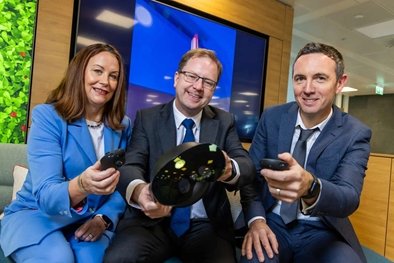With over 30 years’ experience in the telecommunications industry, Nadia Benabdallah, Vodafone’s Director of Network Strategy and Engineering knows a thing or two about mobile networks.
In part one, we explored how Vodafone’s network strategy is evolving to meet the demands of a hyper-connected world, from scaling 5G Standalone to pioneering automation and customer-centric innovation.
But the transformation doesn’t stop there.
In part two, Nadia takes us beyond the horizon into space, quantum computing, and the future of 6G.
Hi Nadia, it’s fantastic to speak to you again. Let’s get into it.
In the network space, what innovation are you most excited about?
One of the most exciting breakthroughs is Satellite Direct-to-Device (D2D) technology using low Earth orbit (LEO) satellites. It’s a game-changer for connectivity.
Vodafone has already proven it’s possible to make calls from satellites directly to regular, unmodified mobile phones with our strategic partner AST SpaceMobile - paving the way for new methods of delivering connectivity to even the most remote and challenging locations.
This marks a major shift in how satellite communications work. We’ve moved from fixed satellite dishes to mobile networks relying on towers, and now to D2D.
Looking ahead, we’re also exploring the potential of LEO satellites that orbit the earth at relatively low altitudes - supporting use cases like cellular backhaul for remote sites - and unlock new services for our customers.
These satellites can provide high-capacity fixed connectivity, and we’re working with partners like Amazon’s Project Kuiper to see how this can support our network.
Innovation isn’t just happening in space. We’re also helping shape the future of 6G through partnerships with organisations like Next Generation Mobile Networks Alliance (NGMN) and Global System for Mobile Communications Association (GSMA). Together, we’re rethinking how networks evolve, moving away from costly hardware upgrades every generation, and instead enabling modular, software-driven updates.
This means we can respond faster to customer needs and roll out new capabilities more flexibly than ever before.
How is Vodafone preparing its network infrastructure for emerging technologies like quantum computing and AI?
Vodafone is taking a proactive, long-term approach to ensure our network is ready for the next wave of technological change, including quantum computing and AI.
We’re working with partners like IBM to make our networks quantum safe. This means strengthening our cybersecurity to protect customer data and network integrity against future threats that quantum computing could pose.
But we’re not stopping at security. We’re also exploring how quantum technologies can help us solve real-world telecom challenges. For example, through our partnership with ORCA Computing in the UK, we’re applying quantum algorithms to improve things like network design and optimisation.
These efforts are part of a broader strategy to future-proof our infrastructure, so we’re not just ready for what’s next, but actively shaping it.
How does Vodafone’s network strategy support its broader purpose of connecting everyone, from seabed to stars?
Our network strategy is fundamentally aligned with our ambition to connect everyone, everywhere - whether on land, under the sea, or in space. This means building a network that is not only high-performing and resilient, but also inclusive, sustainable, and future-ready.
We are investing in next-generation technologies, from subsea cables and terrestrial 5G to satellite-based D2D connectivity. And as I mentioned earlier, our collaborations with pioneering companies, such as AST SpaceMobile, are enabling us to expand connectivity to even the most remote regions.
At the same time, our leadership in industry alliances is driving a more open, modular, and agile vision for next-generation networks like 6G.
Ultimately, our strategy is about more than infrastructure, it’s about enabling opportunity, inclusion, and progress for every person and every business, no matter where they are.
If you could solve one network challenge overnight, what would it be and why?
If I could solve one network challenge overnight, it would be achieving universal, seamless coverage everywhere, for everyone.
Despite all our progress, too many people still lack reliable connectivity. Solving this would unlock access to education, healthcare, and economic opportunities on a global scale. It is the foundation for everything else we hope to build.
Is there anything else you’d like to share about your vision for the future of network technology?
Our industry is at a pivotal moment. Technology is evolving faster than ever, and the boundaries between connectivity, cloud, AI, and cybersecurity are blurring.
My vision is for network technology to become the intelligent backbone of seamless, secure, and personalised digital experiences. To achieve this, we need clarity of purpose across all technology domains. This means leading with focus, simplifying with intent, and aligning our energy around what matters most for our customers and our future.
A borderless future
As we’ve heard from Nadia, Vodafone’s ambitions extend far beyond the ground beneath our feet.
From satellite-to-mobile breakthroughs to quantum-safe networks, Nadia’s insights reveal a future where connectivity knows no bounds.
Reaching every person, place, and possibility from seabed to stars.
Want to know more?
-
Learn more about our Mobile & Fixed networks.
-
Explore how we’re using Quantum Computing.
-
Find out how we’re working with AST SpaceMobile.



























